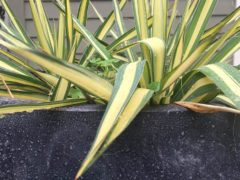
yucca, Adam’s needle
Yucca filamentosa
Excellent for hard to water sites, these plants offer a texture contrast and are adaptable … Continued
Click here for range map, photos, and natural history.
Include these plants in your landscape to host Yucca Moths!
Yucca Moths (Tegeticula sp.)
By Beatriz Moisset, from the US Forest Service
This yucca moth is inside the flower of a yucca, Yucca glauca. Photo by Ann Cooper, BugGuide.net.
Tegeticula sp. Photo by M.J. Hatfield, BugGuide.net.
One of the most extraordinary partnerships between an insect and the plant that it pollinates is that of the yucca and the yucca moth. They are so interdependent that one cannot live without the other. Actually, there are a number of species of yucca, each with its corresponding partner, a species of Tegeticula or Parategeticula moth. This mutually beneficial relationship probably started as a relationship of exploitation with the moth feeding on the yucca. This is still the case with a number of close relatives of Tegeticula, members of the Prodoxidae family.
The yucca moth is a non-descript, small, whitish moth that blends well with the color of the yucca blossoms where it spends most of its brief adult life. A very distinctive feature of Tegeticula is the absence of the long tongue, characteristic of most moths and butterflies. Instead, it has tentacles around its mouth that serve a very important function and make possible its job as a pollinator.
The adult yucca moth does not need to feed because it is so short lived. However, the female gathers pollen, which it holds under its chin with the help of the tentacles. Males and females emerge from their cocoons in the spring in synchrony with the blossoming of the species of yucca with which they are partners. They meet and mate on the yucca blossoms and then the job of the females starts.
She visits the anthers of the flower and scrapes the pollen from several of them shaping it into a large lump. Then she leaves in search of another inflorescence, not just another flower in the same bunch but in a different plant altogether, assuring in this manner the cross pollination of the yucca.
When she arrives at a new plant, she inspects the flowers and chooses the ones that are at the right stage. She also checks if there are already eggs laid in the flower’s ovary. She can detect the smell of other female moths with her antennae and, if another one has been there already, she searches for another flower. This is good for the plant and for the future babies because, if too many eggs were laid in one flower ovary, the flower would abort and the larvae would starve. She lays her eggs in the ovary, no more than a handful; once again, if she laid too many eggs, the flower would abort.
Afterwards she goes to the stigma of the flower and carefully removes some pollen from under her chin and deposits it on the stigma. Now the flower will produce a fruit and enough seeds to feed the larvae as well as ensure the reproduction of the plant.
In a few weeks, the larva is fully-grown. It drops to the ground; it buries itself and makes a cocoon. It will stay underground until the next spring. However, some pupae remain dormant for more than a year. If the yucca fails to bloom one year because of weather conditions, there will still be yucca moths around.
Yuccas are used as ornamentals well beyond their original geographic range. The yucca moths have managed to follow the yucca and have enlarged their range east and north as far as the east coast and Alberta and Ontario in Canada.

Yucca filamentosa
Excellent for hard to water sites, these plants offer a texture contrast and are adaptable … Continued

Yucca filamentosa 'Color Guard'
‘Color Guard’ is a gold-centered variegated yucca with excellent ornamental qualities. It features leaves with … Continued